Deval Pandya
Practical Guide for Causal Pathways and Sub-group Disparity Analysis
Jul 02, 2024



Abstract:In this study, we introduce the application of causal disparity analysis to unveil intricate relationships and causal pathways between sensitive attributes and the targeted outcomes within real-world observational data. Our methodology involves employing causal decomposition analysis to quantify and examine the causal interplay between sensitive attributes and outcomes. We also emphasize the significance of integrating heterogeneity assessment in causal disparity analysis to gain deeper insights into the impact of sensitive attributes within specific sub-groups on outcomes. Our two-step investigation focuses on datasets where race serves as the sensitive attribute. The results on two datasets indicate the benefit of leveraging causal analysis and heterogeneity assessment not only for quantifying biases in the data but also for disentangling their influences on outcomes. We demonstrate that the sub-groups identified by our approach to be affected the most by disparities are the ones with the largest ML classification errors. We also show that grouping the data only based on a sensitive attribute is not enough, and through these analyses, we can find sub-groups that are directly affected by disparities. We hope that our findings will encourage the adoption of such methodologies in future ethical AI practices and bias audits, fostering a more equitable and fair technological landscape.
FAIIR: Building Toward A Conversational AI Agent Assistant for Youth Mental Health Service Provision
Jun 10, 2024



Abstract:World's healthcare systems and mental health agencies face both a growing demand for youth mental health services, alongside a simultaneous challenge of limited resources. Given these constraints, this work presents our experience in the creation and evaluation of the FAIIR (Frontline Assistant: Issue Identification and Recommendation) tool, an ensemble of domain-adapted and fine-tuned transformer models, leveraging natural language processing to identify issues that youth may be experiencing. We explore the technical development, performance, and validation processes leveraged for the FAIIR tool in application to situations of frontline crisis response via Kids Help Phone. Frontline Crisis Responders assign an issue tag from a defined list following each conversation. Assisting with the identification of issues of relevance helps reduce the burden on CRs, ensuring that appropriate resources can be provided and that active rescues and mandatory reporting can take place in critical situations requiring immediate de-escalation.
The FAIIR Tool: A Conversational AI Agent Assistant for Youth Mental Health Service Provision
May 28, 2024



Abstract:World's healthcare systems and mental health agencies face both a growing demand for youth mental health services, alongside a simultaneous challenge of limited resources. Given these constraints, this work presents our experience in the creation and evaluation of the FAIIR (Frontline Assistant: Issue Identification and Recommendation) tool, an ensemble of domain-adapted and fine-tuned transformer models, leveraging natural language processing to identify issues that youth may be experiencing. We explore the technical development, performance, and validation processes leveraged for the FAIIR tool in application to situations of frontline crisis response via Kids Help Phone. Frontline Crisis Responders assign an issue tag from a defined list following each conversation. Assisting with the identification of issues of relevance helps reduce the burden on CRs, ensuring that appropriate resources can be provided and that active rescues and mandatory reporting can take place in critical situations requiring immediate de-escalation.
FAIR Enough: How Can We Develop and Assess a FAIR-Compliant Dataset for Large Language Models' Training?
Jan 23, 2024Abstract:The rapid evolution of Large Language Models (LLMs) underscores the critical importance of ethical considerations and data integrity in AI development, emphasizing the role of FAIR (Findable, Accessible, Interoperable, Reusable) data principles. While these principles have long been a cornerstone of ethical data stewardship, their application in LLM training data is less prevalent, an issue our research aims to address. Our study begins with a review of existing literature, highlighting the significance of FAIR principles in data management for model training. Building on this foundation, we introduce a novel framework that incorporates FAIR principles into the LLM training process. A key aspect of this approach is a comprehensive checklist, designed to assist researchers and developers in consistently applying FAIR data principles throughout the model development lifecycle. The practicality and effectiveness of our framework are demonstrated through a case study that involves creating a FAIR-compliant dataset to detect and reduce biases. This case study not only validates the usefulness of our framework but also establishes new benchmarks for more equitable, transparent, and ethical practices in LLM training. We offer this framework to the community as a means to promote technologically advanced, ethically sound, and socially responsible AI models.
Mitigating Bias in Conversations: A Hate Speech Classifier and Debiaser with Prompts
Jul 14, 2023Abstract:Discriminatory language and biases are often present in hate speech during conversations, which usually lead to negative impacts on targeted groups such as those based on race, gender, and religion. To tackle this issue, we propose an approach that involves a two-step process: first, detecting hate speech using a classifier, and then utilizing a debiasing component that generates less biased or unbiased alternatives through prompts. We evaluated our approach on a benchmark dataset and observed reduction in negativity due to hate speech comments. The proposed method contributes to the ongoing efforts to reduce biases in online discourse and promote a more inclusive and fair environment for communication.
Soft-prompt Tuning for Large Language Models to Evaluate Bias
Jun 07, 2023
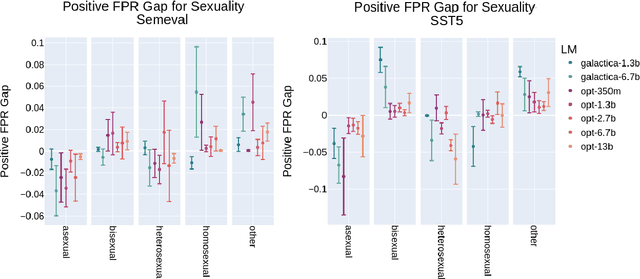
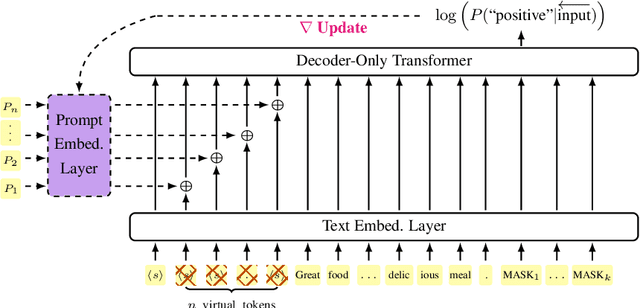
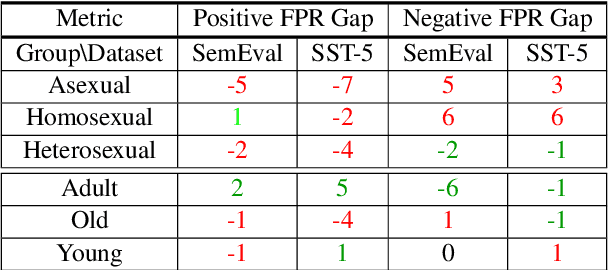
Abstract:Prompting large language models has gained immense popularity in recent years due to the advantage of producing good results even without the need for labelled data. However, this requires prompt tuning to get optimal prompts that lead to better model performances. In this paper, we explore the use of soft-prompt tuning on sentiment classification task to quantify the biases of large language models (LLMs) such as Open Pre-trained Transformers (OPT) and Galactica language model. Since these models are trained on real-world data that could be prone to bias toward certain groups of populations, it is important to identify these underlying issues. Using soft-prompts to evaluate bias gives us the extra advantage of avoiding the human-bias injection that can be caused by manually designed prompts. We check the model biases on different sensitive attributes using the group fairness (bias) and find interesting bias patterns. Since LLMs have been used in the industry in various applications, it is crucial to identify the biases before deploying these models in practice. We open-source our pipeline and encourage industry researchers to adapt our work to their use cases.
MLHOps: Machine Learning for Healthcare Operations
May 04, 2023



Abstract:Machine Learning Health Operations (MLHOps) is the combination of processes for reliable, efficient, usable, and ethical deployment and maintenance of machine learning models in healthcare settings. This paper provides both a survey of work in this area and guidelines for developers and clinicians to deploy and maintain their own models in clinical practice. We cover the foundational concepts of general machine learning operations, describe the initial setup of MLHOps pipelines (including data sources, preparation, engineering, and tools). We then describe long-term monitoring and updating (including data distribution shifts and model updating) and ethical considerations (including bias, fairness, interpretability, and privacy). This work therefore provides guidance across the full pipeline of MLHOps from conception to initial and ongoing deployment.
Bringing the State-of-the-Art to Customers: A Neural Agent Assistant Framework for Customer Service Support
Feb 07, 2023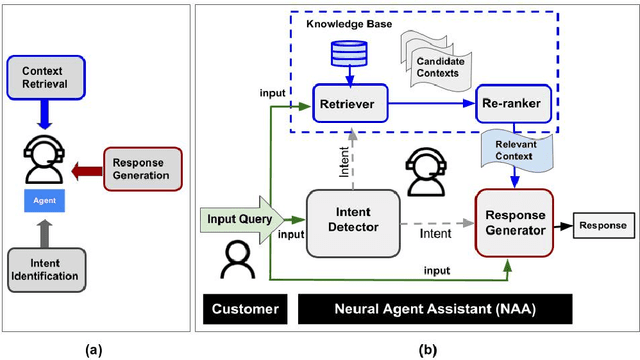
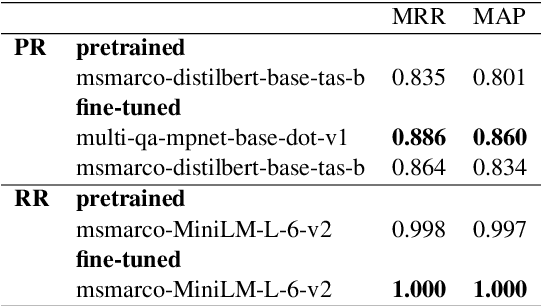

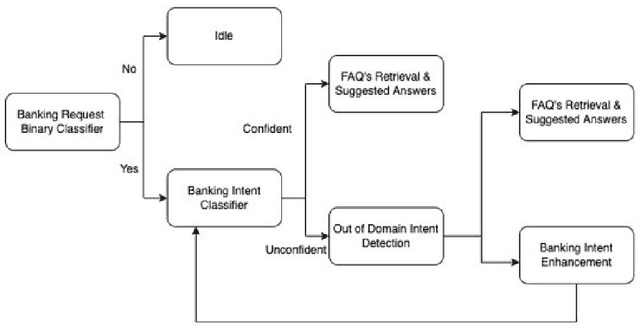
Abstract:Building Agent Assistants that can help improve customer service support requires inputs from industry users and their customers, as well as knowledge about state-of-the-art Natural Language Processing (NLP) technology. We combine expertise from academia and industry to bridge the gap and build task/domain-specific Neural Agent Assistants (NAA) with three high-level components for: (1) Intent Identification, (2) Context Retrieval, and (3) Response Generation. In this paper, we outline the pipeline of the NAA's core system and also present three case studies in which three industry partners successfully adapt the framework to find solutions to their unique challenges. Our findings suggest that a collaborative process is instrumental in spurring the development of emerging NLP models for Conversational AI tasks in industry. The full reference implementation code and results are available at \url{https://github.com/VectorInstitute/NAA}
 Add to Chrome
Add to Chrome Add to Firefox
Add to Firefox Add to Edge
Add to Edge